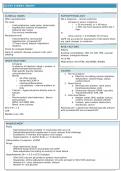ACUTE KIDNEY INJURY
CLINICAL SIGNS PATHOPHYSIOLOGY
Often asymptomatic Not a diagnosis – clinical syndrome
Pre-renal - Increase in serum creatinine
- Cold peripheries, weak pulse, tachycardia o > 26 micromol/L in < 48 hours
- Hypotension (relative to baseline) o > 50% rise from baseline within last 7
- Reduced skin turgot days
- Dry mucous membranes or
Renal/post-renal - Urine volume < 0.5ml/kg/hr for 6 hours
- Cold peripheries, tachycardia eGFR not accurate for assessment of AKI where there
- Hypertension, increased JVP are rapid changes in creatinine
- 3rd heart sound, bibasal crepitations
- Oedema RISK FACTORS
Check for enlarged bladder Elderly
Signs of systemic disease: purpuric rash, joint Existing comorbidities: CKD, HF, DM, HTN, vascular
swelling disease, urological disease
Hx of AKI
INVESTIGATIONS Medications: Anti-HTNs, ACEi/ARBs, NSAIDs
- Urinalysis
- In absence of infection: blood + protein
glomerulonephritis/vasculitis
- High specific gravity indicates CAUSES
concentrated urine 1. Pre-renal failure
- Bloods a. Effective circulating volume depletion:
o Hb often normal dehydration, haemorrhage, sepsis,
o Raised WCC/CRP in cardiac failure
infection/inflammation 2. Renal failure
o Low platelets – marrow problem or a. Renovascular disease: renal artery
HUS thrombosis/embolus, HUS
- Calcium – hypercalcaemia directly toxic to b. Glomerular disease: RPGN, vasculitis
tubules c. Tubulointerstitial: ATN, AIN
- CK 3. Post-renal failure
- Plasma protein electrophoresis – Bence a. Bladder outlet: BPH, bladder tumour,
Jones protein ureteric stricture, blocked catheter
- ANCA, Anti-GBM, ANA b. Ureteric: pelvi-ureteric obstruction,
- Blood, urine cultures stones/clot, cancer
ECG if K+ > 6 Renovascular + glomerular disease typically present
CXR with increased BP and increased ECF
Bladder scan, USS
MANAGEMENT
Fluids
- Haemodynamically unstable resuscitate with up to 2L
- Dehydration/postural hypotension more cautious fluid challenge
- Euvolaemic monitor and replace urine output
- Hypervolaemic restrict fluids +/- IV diuretics or dialysis
Catherisation if suspicion of BOO
Drugs:
- Stop nephrotoxic drugs
- Withhold drugs likely to exacerbate low eGFR
- Dose adjustment according to severity of renal failure
Hyperkalaemia (K+ > 6.5 or ECG changes)
- 30ml 10% calcium gluconate to protect myocardium
- Oxygenate, 10mls salbutamol nebuliser, 10 units actrapid in 50ml 50% dextrose
- Remove K+: urine, potassium binder, dialysis
- Monitor K+ and glucose
,RENOVASCULAR DISEASE
LARGE VESSEL OCCLUSION PATHOPHYSIOLOGY
Main renal artery thrombosis/embolus Renal cause of AKI
- Must be bilateral to cause AKI (or unilateral Typically presents with volume expansion
if single functioning kidney)
- Oliguria/anuria
- Mild loin pain (if any)
- Doppler USS/CT angio shows lack of renal
SMALL VESSEL OCCLUSION – CHOLESTEROL
blood flow EMBOLI
Renal cause of AKI
Revascularisation rarely able to save renal
function Common after arterial procedures (e.g. coronary
angiogram)
Often associated with eosinophilia
MICROANGIOPATHIC HAEMOLYTIC
O/E: may see ischaemia of the toes, often with
ANAEMIA
relatively well-preserved pulses
Presenting feature of small vessel renal disease
Biopsy would show cholesterol emboli in small
- HTN vessels leading to the kidney
- Thrombocytopenia
- Haemolysis: schistocytes on blood film
o Raised LDH
o Raised unconjugated bilirubin HAEMOLYTIC URAEMIC SYNDROME
o Low haptoglobin Generally seen in young children
Renal biopsy: glomerular microthrombi – capillary Produces triad of
loops are occluded with microthrombi so GFR is 1. AKI
low 2. Microangiopathic haemolytic anaemia
Can be caused by 3. Thrombocytopenia
- HUS Most are secondary: Shiga toxin-producing E. coli,
- Thrombotic thrombocytopenic purpura pneumococcal infection, HIV, SLE, drugs, cancer
- Systemic sclerosis Primary HUS (atypical) is due to complement
- Malignant HTN (typically SBP > 200mmHg) dysregulation
Treatment is supportive (no role for abx despite
preceding diarrhoeal illness in many patients)
, ACUTE INTERSTITIAL NEPHRITIS
CLINICAL SIGNS PATHOPHYSIOLOGY
AKI/clinically silent Immune-mediated disorder characterised by acute
- Reduction in renal function over weeks inflammation affecting the tubule-interstitium of the
months kidney
- Urine output often preserved, may have
polyuria/nocturia Most commonly an allergic drug reaction most
o Although GFR is reduced, the common, but can be autoimmune. Looks the same as
injured tubules aren’t able to acute rejection of a kidney transplant
reabsorb salt and water as well as
normal leading to leakage of salt Toxins can also cause AIN – plant toxics, chemical
and water toxins, autotoxins from myeloma kidney
- Normally euvolaemic, normotensive
- Urinalysis bland, may see leukocytes
- May have eosinophilia
Often requires biopsy to confirm diagnosis CAUSES
In immune AIN there may be other features such Drugs
as rash, peripheral eosinophilia - Penicillin
May have: - NSAIDs
- Modest proteinuria - PPIs
- Urine may contain WCCs and WC casts - Mesalazine (delayed)
- Eosinophils present in up to 70% patients Infections
- Pyelonephritis
- TB
INVESTIGATIONS - Leptospirosis
- Hantavirus
Renal biopsy – evidence of intense inflammation
with infiltration of tubules and interstitium by Immune
polymorphonuclear leucocytes and lymphocytes. - Autoimmune disease
Eosinophils may be observed - Transplant disease
Often granulomas are evident, especially in drug- Sarcoidosis
induced AIN or sarcoidosis
Toxic – myeloma light chains, mushrooms
MANAGEMENT
Stop offending drug if possible
Consider steroids to accelerate resolution
Infection = abx
Immune = immunosuppression
Sarcoidosis = steroids




